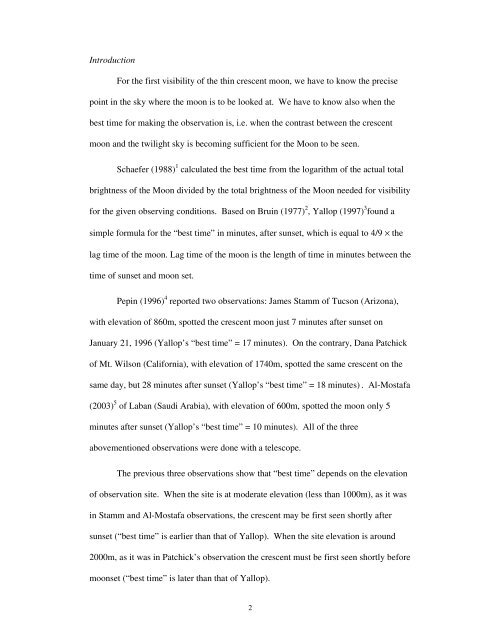sultan_2006
Topics RECONSTRUCTION, SCHAEFER, SCHAEFER'S FORMULA, LUNAR VISIBILITY, VISIBILITY OF LUNA, BRIGHTNESS OF CRESCENT, MOON, QAMAR, HILAL, RUYAH TUL HILAL, CRESCENT OF LUNA, LUNA'S CRESCENT, SCHAEFERS, CRITERION, REDISCOVERING SCHAEFER, S FORMULA
Topics RECONSTRUCTION, SCHAEFER, SCHAEFER'S FORMULA, LUNAR VISIBILITY, VISIBILITY OF LUNA, BRIGHTNESS OF CRESCENT, MOON, QAMAR, HILAL, RUYAH TUL HILAL, CRESCENT OF LUNA, LUNA'S CRESCENT, SCHAEFERS, CRITERION, REDISCOVERING SCHAEFER, S FORMULA
Create successful ePaper yourself
Turn your PDF publications into a flip-book with our unique Google optimized e-Paper software.
Introduction<br />
For the first visibility of the thin crescent moon, we have to know the precise<br />
point in the sky where the moon is to be looked at. We have to know also when the<br />
best time for making the observation is, i.e. when the contrast between the crescent<br />
moon and the twilight sky is becoming sufficient for the Moon to be seen.<br />
Schaefer (1988) 1 calculated the best time from the logarithm of the actual total<br />
brightness of the Moon divided by the total brightness of the Moon needed for visibility<br />
for the given observing conditions. Based on Bruin (1977) 2 , Yallop (1997) 3 found a<br />
simple formula for the “best time” in minutes, after sunset, which is equal to 4/9 × the<br />
lag time of the moon. Lag time of the moon is the length of time in minutes between the<br />
time of sunset and moon set.<br />
Pepin (1996) 4 reported two observations: James Stamm of Tucson (Arizona),<br />
with elevation of 860m, spotted the crescent moon just 7 minutes after sunset on<br />
January 21, 1996 (Yallop’s “best time” = 17 minutes). On the contrary, Dana Patchick<br />
of Mt. Wilson (California), with elevation of 1740m, spotted the same crescent on the<br />
same day, but 28 minutes after sunset (Yallop’s “best time” = 18 minutes) . Al-Mostafa<br />
(2003) 5 of Laban (Saudi Arabia), with elevation of 600m, spotted the moon only 5<br />
minutes after sunset (Yallop’s “best time” = 10 minutes). All of the three<br />
abovementioned observations were done with a telescope.<br />
The previous three observations show that “best time” depends on the elevation<br />
of observation site. When the site is at moderate elevation (less than 1000m), as it was<br />
in Stamm and Al-Mostafa observations, the crescent may be first seen shortly after<br />
sunset (“best time” is earlier than that of Yallop). When the site elevation is around<br />
2000m, as it was in Patchick’s observation the crescent must be first seen shortly before<br />
moonset (“best time” is later than that of Yallop).


















